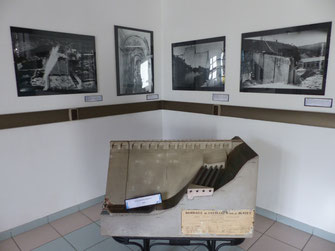

The Guerlédan dam was built in the 1920s and played a major role in the electrification of Central Brittany.
The original model of the dam and the photographs of Ernest Blat allow us to trace the construction of this concrete colossus.
There is also a virtual visit to the hydroelectric site, film screenings on the operation of a hydroelectric power plant and a video of the draining of Guerlédan Lake in 2015.


What is the path of electricity from the power plant to the plug socket? What are the different sources of energy?
The exhibits in this room will allow you to understand aspects of production, transformation and distribution.
To remind us of how industrial electricity evolved in the 20th century there are exhibits which include the turbine and alternator, insulators, transformers and public lighting.


Electricity has been used in all areas of our society: Medicine, transport, leisure, agriculture...
By freeing up the workforce, the electrification of the countryside has had an impact on the functioning of society and our relationship with work.
The first projector from the Rex cinema in Pontivy (1935), an x-ray booth and electrotherapy equipment, a "Block Lartigue" rail system and other agricultural equipment are presented in this room.


How does a battery or an alternator work? What is an electric current, what are watts, volts ...? Find the answers to your questions.
Who are the scientists without whom the history of electricity would not have been possible? Thales of Milet and static electricity, 2500 years ago; Volta, Faraday or Ampère in the 19th and 20th century. So many people… You’ll also find here some very useful measuring devices from the last century!


Electricity gradually appeared in homes between the two world wars but really took off in the 1950s and 1960s.
From the single light bulb in the house, to telephones, radios, televisions, vacuum cleaners... Discover the history of the appliances and gadgets that we now use every day.

